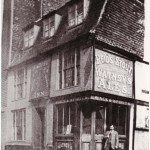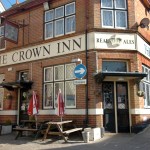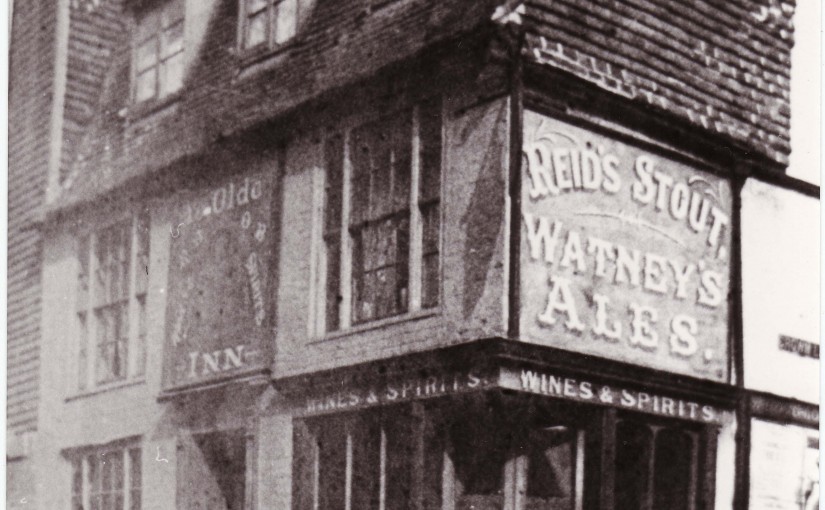By John Hodges
In the days that Hastings had a town wall it would not have been surprising to find allusions to it in the names of the adjoining streets. Indeed, High Street itself developed along what was the road leading from the Sea Gate, whilst across the valley of the Bourne, All Saints Street was originally known as the ‘Kings Highways leading from the Pulpit Gate to the Minnes’. It was not till sometime after the building of the present All Saints Church during the 15th Century that All Saints Street received its present name despite being known for a period as Fisher Street, a name consistent with the calling of many of its inhabitants.


Over the years many small Inns and Beer houses built in the area to serve what was essentially a fishing community, have disappeared. Some closed through reasons of redundancy, whilst others fell foul of the march of progress. Old Inns with quaint names such as “Ye Olde House at Home” and the “Hope of Freedom”, once stood in All Saints Street but failed to survive the test of time. However, one such Inn that has survived is the Crown, an ancient house that now stands at the foot of Crown Lane. The original Crown was an Inn standing near the old Court Hall in Courthouse Street and was owned during the 17th Century by the Manor of Brede. We know that in 1639 the heirs of James Lasher paid a quitrent to that manor for the property. The Crown probably moved to its present site during the early part of the 18th Century where greater scope for subsequent expansion lie, than in the congested area of Courthouse Street. From 1794 until 1814 the Crown was held by William Smith, with his wife Sarah taking over between 1815 and 1832 a period of relative stability for what was then an important hostelry. Powell’s guide of 1831 heaps praise on Sarah Smith for her abilities as mine host, and her unrivalled attention to the comforts of her guests.
We know that by 1745 a weekly coach was leaving the Swan Hotel in the High Street for London and it may well have been this opening of communication with the outside world that prompted the development of the Crown across the other side of the Valley. The original Crown had extensive stabling on what was to be the site of Scriven’s Buildings while the actual boundaries extended the length of Crown Lane as far as Tackleway. Crown Lane was described for many years as extremely rugged, and did not assume the qualities of a passable road until 1852. In earlier days Crown Lane ascended the lower part of what was then known as “St. George Hylls” , now the East Hill, with the original name mistakenly perpetuated in St George’s Churchyard, and quite possibly in The George Inn an ancient hostelry that once occupied the site of what is today the Stag Inn. The Crown at one time was owned by that notable public figure John Collier who no doubt was instrumental in its efforts to rival the Swan as the leading hostelry of the day. As Brett tells us the Crown, was occupied by aristocratic families and fashionable visitors who not only came to Hastings to bathe, but to drink the sea water as well, politely described in the fashionable guides of the day as “taking the waters”. Brewing beer would not have been a problem either on the premises or local to them, as many small brewers existed in the Old Town of Hastings prior to the formation of the more famous local brewers such as Burfields and Breeds. Hops, malt and even “water” was available locally, certainly until the Bourne was culverted in the 1830’s. The demise of the Bourne as a supply of clean water probably did more to influence local innkeepers to look to the large brewers with ready access to wells for their supply of ale, than anything else.
By the early part of the last century the Crown was owned by the Hastings Cottage Improvement Society, who with other builders, had certainly developed much of the Inn’s estate into cottages and tenement blocks leaving the pub itself a mere shadow of its former self. However prior to this period of realignment of the property, the pub continued to prosper with a whole range of community activities, from a Buffaloes Lodge to the All Saints Conservative Association, availing themselves of its then extensive facilities. Following the significant change in the size of the estate one of the first landlords to take on the “new hostelry”, which was now know as Ye Olde Crown House, was one Alexander Littlejohn. Whilst his association with the pub was unremarkable, his later employment as a steward aboard the ill fated liner Titanic most certainly was not. Following the collision with an iceberg, he was ordered to row lifeboat 13 from which he witnessed first-hand the terrible tragedy and loss of life as the Titanic went down into the depths of the Atlantic Ocean. It is interesting to note that his boat rescued amongst others the youngest person on board the ill fated liner, nine week’s old Millvina Dean who subsequently became by the time of her death in 2009, the longest surviving passenger.
In 1921 The Crown was gutted by fire, and this gave the then owners Watney, Combe Reid and Company an opportunity to build a new Pub on the much reduced site of the former coaching Inn. The pub remained in the hands of Watneys for many years, and certainly in the period following the second world war it probably enjoyed its busiest times when ownership of a television set was beyond the pocket of many working people, and the local pub provided much of the community entertainment. Certainly the longest serving hosts that are recorded were George and Rosetta Lee, where for thirty one years they ministered to the bibulous needs of Old Hastings. A much respected family noted for their continuing help and kindness to those left behind during the periods of evacuation that occurred throughout the last war. The next major change occurred in 1984, when Harveys the Lewes’ Brewers opened the Crown as their first tied house in
Hastings offering once again locally produced ales that I am sure would never have tempted any of today’s visitors to drink sea-water in preference. However this relationship did not last for too long and the pub was sold on again, until the final landlady Linda Burrage who held the license for ten years in the face of declining trade, the smoking ban, and a changing social culture, finally decided that the time had come to part company with this old inn. It is a sad indictment of the times that we continue to bear witness to the demise of so many of these ancient hostelries, and certainly one that has played such a significant role in the history of our Town will be sadly missed.
“Hastings Town” February 2013
All articles, photographs, films and drawings on this web site are World Copyright Protected. No reproduction for publication without prior arrangement. (Hard Copy Back Numbers Still Available) © World Copyright 2015 Cinque Ports Magazines Rye Ltd., Guinea Hall Lodge Sellindge TN25 6EG
